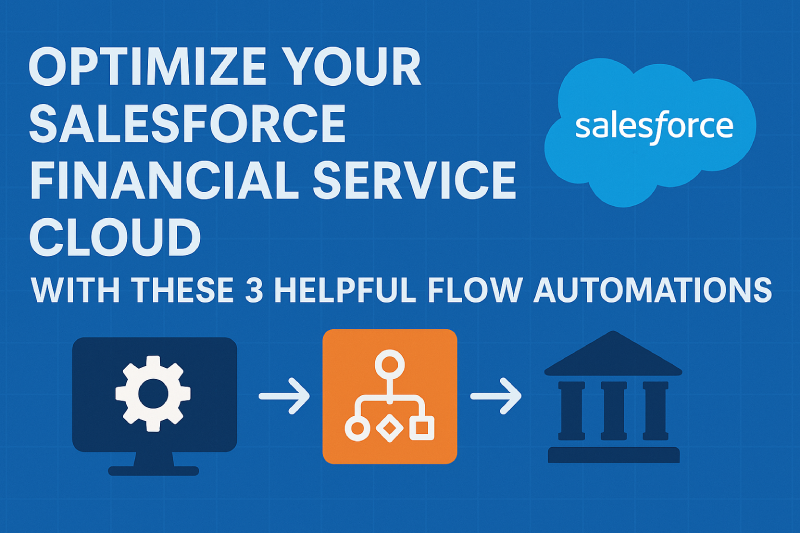
21 Aug Optimize Your Salesforce Financial Services Cloud With These 3 Helpful Flow Automations
Salesforce Financial Services Cloud (FSC) is a powerful tool for managing client relationships and driving efficiencies in the financial sector. However, the true potential of FSC lies in leveraging its automation capabilities to streamline processes, reduce manual effort, and ensure data integrity. In this article, we’ll explore three impactful Flow automations that can optimize your Salesforce FSC environment to align it with your unique business needs.
1. Client Records Deduplication Automation
Duplicate records can quickly erode the quality of your Salesforce data, especially if you have integrations to external core systems that are bringing data into Salesforce on a daily basis.
Let’s take the example of a banking institution:
The retail banking team might be creating prospects (Leads in Salesforce) to keep track of individuals who are interested in opening a checking/savings account or applying for a loan. The Lead record would then be converted by the team in Salesforce resulting in an Opportunity record as well as an Account/Contact record. If that prospect later becomes a client of the bank, a client record will be created in the banking core system and sent over to Salesforce as an Account/Contact record, resulting in duplicate records.
With a well-designed Salesforce Flow, you can automatically identify and resolve duplicate Accounts/Contacts, ensuring clean and accurate client records.
Here’s how it works:
- The Flow can trigger when a new client record is created or updated.
- Using decision logic, the Flow checks for potential duplicates based on fields like First Name, Last Name, Email, Phone Number, etc.
- Note: An external Duplicate Flow Component such as the “Duplicate Record Check” by unofficialsf.com can be downloaded and configured.
- When duplicates are identified, the Flow can either merge records automatically or create tasks for a user to manually review them.
By automating deduplication, you maintain high data integrity and enable your team to focus on building meaningful client relationships rather than cleaning up data.
2. Lead / Contact Management for Marketing Platforms
Automatically syncing the right audience from your Salesforce FSC to Marketing Cloud, or to Account Engagement (formerly Pardot), boosts your marketing effectiveness and campaign/journey segmentation.
A Salesforce Flow can help ensure your Leads and Contacts are appropriately synced with Marketing Cloud/Account Engagement depending on the conditions that you determine.
For example, you might want to ask yourself the following questions to segment your audience:
- Are you targeting both prospecting clients and current clients of your financial institution?
- Do you also need to reach out to former clients to re-engage them?
- For prospecting clients, are you only reaching out to prospects which have shown a significant interest in becoming a client?
A custom checkbox field, such as “Sync to Marketing Cloud” or “Sync to Account Engagement” can act as a flag for determining which records are eligible for synchronization.
Using a Flow, you can:
- Automatically check or uncheck a custom checkbox field based on predefined conditions, such as whether the Contact has opted into marketing communications or belongs to a specific segment.
- Trigger this Flow whenever a Lead or Contact is updated to ensure real-time alignment with your marketing platforms. For example, if an email address is added onto the Lead record you may want to start syncing this Lead from now on.
This automation ensures efficient use of Marketing Cloud / Account Engagement storage and guarantees your campaigns are reaching the right audience at the right time.
3. Industry-Specialized Workflows
One of the standout features of Salesforce FSC is the availability of native, templated Flow automations tailored to specific industries such as banking, insurance, and wealth management. These pre-built automations provide a head start in implementing industry-specific workflows, saving time and ensuring best practices.
These flows can be found in your Salesforce FSC under Setup → Flows. To start using one of the templated Flows, click on the Flow name and save the flow as a “New Flow” to start customizing it.
Examples include:
- Banking: Automated onboarding processes for new clients, including document collection and account setup tasks.
- Insurance: Policy renewal reminders and claims processing workflows.
- Wealth Management: Scheduling and tracking client review meetings with automated follow-ups.
By leveraging these templated Flows, you can quickly implement industry-standard processes while customizing them to fit your unique business requirements.
Conclusion
Salesforce Financial Services Cloud (FSC), when combined with the power of Flows, becomes a powerful tool for automating tedious tasks, enhancing data quality, and delivering personalized client experiences. By implementing these three Flow automations, you can enable your teams to have easy access to reliable and comprehensive data about your prospecting, current, and former clients.
As Salesforce certified consultants, we’re here to help you harness the full potential of FSC and tailor it to your business needs. Reach out today at contact@offprem.tech to schedule a call and start your journey toward smarter financial services management!
